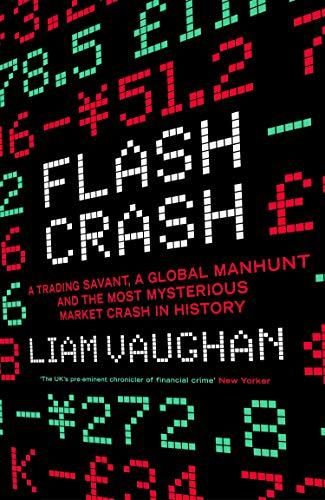Award-winning financial journalist Liam Vaughan investigates a curious financial crime with far-reaching implications.

Man Against the Markets
Bloomberg and Bloomberg Businessweek investigative reporter Liam Vaughan – winner of the Gerald Loeb Award for financial journalism – details the saga of eccentric financial criminal Navinder Sarao, who employed deceitful trading tactics to amass tens of millions of dollars. Yet even as his millions stacked up, the socially awkward young man went on living with his parents and eating at McDonald’s.
Vaughan knows international finance intimately, but it never awes him. He presents Sarao’s life as a trader and his ultimate conviction by US authorities – who accused him of sparking a brief but dramatic stock market crash – as a minor but resonant tragedy. Vaughan doesn’t regard Sarao as evil but rather as a natural product of the modern financial system.
Navinder Sarao
A child of Indian immigrants, in 2003 Navinder Sarao responded to an ad in London’s Evening Standard seeking rookie traders. Gifted in arithmetic, Sarao took part in an eight-week training program, but he seldom socialized with his fellow trainees.
When the panelists asked him what he hoped to achieve in his career, he replied, straight-faced, that he wanted to be as rich as Warren Buffett and start his own charity.Liam Vaughan
Wearing industrial-grade ear protection, Sarao would stare at screens for hours, focused on trading. He concentrated on the S&P 500 E-Mini, a futures contract based on the direction of US securities.
On a profitable day, Sarao could make $20,000 to $25,000. Trading with his brokerage firm’s money, he took big positions, routinely putting $7 million at risk. By 2007, Sarao had amassed $400,000, and unprofitable days did not daunt him. In January 2008, he began taking larger positions – up to $15 million – and holding them overnight.
Most day traders harbored a degree of resentment toward the HFTs [high-frequency traders], but for Nav, who had a fierce anti-authoritarian streak, it tapped into something deeper.Liam Vaughan
Companies with rapid algorithm-directed trades were anathema to Sarao, who clicked a mouse for each market move.
$15 Million
The 90/10 split at his brokerage company meant Sarao turned over $5,000 a day to his employer, plus perhaps $2,000 in commissions. When the S&P 500 hit bottom in November 2008, Sarao felt shares would rebound. By buying S&P 500 futures, he made $15 million in a week.
Traders, Vaughan explains, gamed the market by placing orders above or below the going price and canceling those orders before they were executed. In March 2009, the Chicago Mercantile Exchange (CME) warned Sarao that his orders had to be “bona fide.”
It’s difficult to imagine what it must feel like to invent a machine that prints money and then not tell anyone about it, but that’s essentially what Nav had done.Liam Vaughan
Sarao contracted American software designers to build a trading program that would mislead traders. The program’s “cancel if close” feature let Sarao place hefty orders just above the best offer. Trading from his parents’ house, Sarao made $876,823 in one session in 2010. During another, he cashed in $435,185.
Flash Crash
Sarao made $200 million of “spoof offers,” as his tactics were known. In one two-hour period, he bought and sold S&P 500 contracts with a value of $3.4 billion and made $879,018. He shut off his program at 1:41 p.m. Chicago time, and stocks crashed. The S&P 500 plunged 5% in four minutes, followed by the Dow. Stocks reacted crazily; for example, Accenture sold for a penny a share, while Apple soared to $100,000 per share.
From Frankfurt to Shanghai, interconnected financial markets went haywire, an apocalyptic nightmare scenario playing out in fast-forward.Liam Vaughan
Investors, traders and the media pointed to algorithmic trading as the cause of the “Flash Crash.” Regulators were clueless. In fact, two crashes occurred: One from 1:41 pm to 1:45 pm and another, involving individual stocks, from 1:45 pm to 2 pm.
“Massive Manipulation”
On August 4, 2011, Sarao booked a profit of $4.1 million as the S&P 500 fell 4.8%. To avoid taxes, he moved his profits into trusts registered in Nevis. He pledged $16 million to a wind energy scheme he thought would earn close to $400 million. But Sarao knew nothing about managing his fortune; it would turn out that he had invested in a Ponzi scheme.
US authorities did not notice Sarao’s trades before the Flash Crash, but a Chicago trader testing a new system using data from the day of the crash noted suspicious activity: Someone had placed large blocks of sell orders for amounts above the best order. Those sell orders then moved with the market – unexecuted. This signaled massive manipulation.
Did one of the five biggest S&P traders in the world really operate from a semidetached house in suburbia?Liam Vaughan
The US Commodity Futures Trading Commission had to bring charges within five years of the Flash Crash. When investigators gained access to Sarao’s emails, they found some – but not conclusive – incriminating material. In April 2015, FBI agents and US prosecutors flew to London to coordinate with British police to raid Sarao’s home.
Sarao’s arrest provoked incredulous responses. A Financial Times columnist and a Columbia University professor wondered how a guy working from his bedroom could outsmart the world’s most sophisticated traders. The little guy was taking the fall for the HFT power brokers, they argued.
Sarao languished in jail in Britain, unable to post bail because much of his fortune was tied up in the fraudulent investment. Authorities seized computers and discovered videos proving he had repeatedly broken the law. Sarao pleaded guilty and testified in the federal case against the software developer who had created Sarao’s trading program.
What had possessed him to document his exploits this way was a mystery, like a robber who takes selfies outside the banks he has hit and leaves them on his phone.Liam Vaughan
The US Justice Department went easy on him: One year of home confinement – at his parents’ house.
Review
This is an incredibly compelling story. Vaughan writes with verve and lets no small irony go unnoticed. Unlike his most likely comparison, Michael Lewis, Vaughan takes a compassionate tone and frames the action in the context of an insane wealth and privilege imbalance. He doesn’t exactly regard Sarao as a hero, but he admires Sarao’s pluck and agrees he was a handy scapegoat. Vaughn makes clear that Sarao’s arrest deflected attention from more corporate, established culprits.
Those working in the markets will revel in Vaughan’s insider details. Those who know nothing of international finance will still enjoy Sarao’s journey. Vaughan’s writing chops and business knowledge make this a terrific, informative read.
Liam Vaughan was co-author of The Fix with Gavin Finch. Other worthy books about the current financial system include Flash Boys and The Big Short by Michael Lewis, and The Man Who Solved the Market by Gregory Zuckerman.





